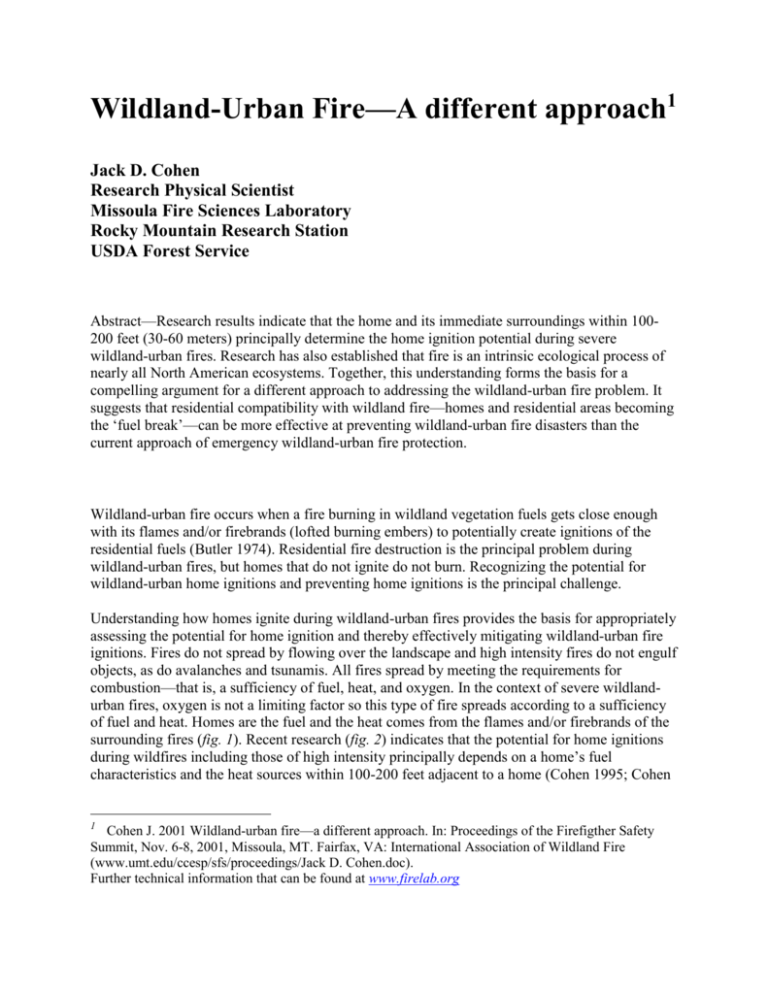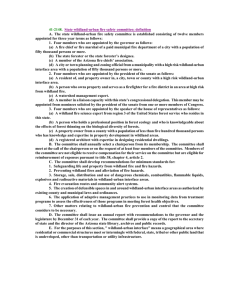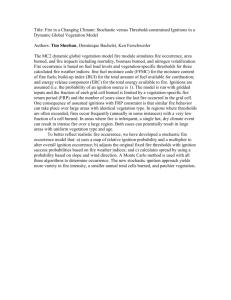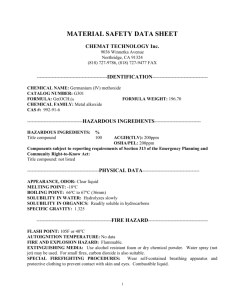has to say
advertisement

Wildland-Urban Fire—A different approach1 Jack D. Cohen Research Physical Scientist Missoula Fire Sciences Laboratory Rocky Mountain Research Station USDA Forest Service Abstract—Research results indicate that the home and its immediate surroundings within 100200 feet (30-60 meters) principally determine the home ignition potential during severe wildland-urban fires. Research has also established that fire is an intrinsic ecological process of nearly all North American ecosystems. Together, this understanding forms the basis for a compelling argument for a different approach to addressing the wildland-urban fire problem. It suggests that residential compatibility with wildland fire—homes and residential areas becoming the ‘fuel break’—can be more effective at preventing wildland-urban fire disasters than the current approach of emergency wildland-urban fire protection. Wildland-urban fire occurs when a fire burning in wildland vegetation fuels gets close enough with its flames and/or firebrands (lofted burning embers) to potentially create ignitions of the residential fuels (Butler 1974). Residential fire destruction is the principal problem during wildland-urban fires, but homes that do not ignite do not burn. Recognizing the potential for wildland-urban home ignitions and preventing home ignitions is the principal challenge. Understanding how homes ignite during wildland-urban fires provides the basis for appropriately assessing the potential for home ignition and thereby effectively mitigating wildland-urban fire ignitions. Fires do not spread by flowing over the landscape and high intensity fires do not engulf objects, as do avalanches and tsunamis. All fires spread by meeting the requirements for combustion—that is, a sufficiency of fuel, heat, and oxygen. In the context of severe wildlandurban fires, oxygen is not a limiting factor so this type of fire spreads according to a sufficiency of fuel and heat. Homes are the fuel and the heat comes from the flames and/or firebrands of the surrounding fires (fig. 1). Recent research (fig. 2) indicates that the potential for home ignitions during wildfires including those of high intensity principally depends on a home’s fuel characteristics and the heat sources within 100-200 feet adjacent to a home (Cohen 1995; Cohen 1 Cohen J. 2001 Wildland-urban fire—a different approach. In: Proceedings of the Firefigther Safety Summit, Nov. 6-8, 2001, Missoula, MT. Fairfax, VA: International Association of Wildland Fire (www.umt.edu/ccesp/sfs/proceedings/Jack D. Cohen.doc). Further technical information that can be found at www.firelab.org 2000; Cohen and Butler 1998). This relatively limited area that determines home ignition potential can be called the home ignition zone (fig. 3). Figure 1—In the context of wildland-urban fires, the homes are the fuel. The heat comes from burning materials adjacent to the home (e.g., vegetation, wood piles, and buildings) and firebrands (lofted burning embers) on the home. How close flames are to the home and whether or not firebrands contact the home determines how much heat the home receives. (a) (b) Figure 2—Home ignition research over the last several years has exposed wall sections to crown fires. (a) Wall sections were placed at 33, 66, and 98 feet from the forest edge. (b) Ignition of the 33 ft wall section occurred during 3 out of 7 crown fires. No ignitions or significant scorch occurred on wall sections at 66 ft and 98 ft during any crown fire. Figure 3—The home ignition zone includes the home and an area surrounding the home within 100 to 200 feet. The potential for ignition depends on the home’s exterior materials and design and the amount of heat to the home from the flames within the home ignition zone. Firebrand ignitions also depend on the home ignition zone either by igniting the home directly or igniting adjacent materials that heat the home to ignition. During a wildland-urban fire a home ignites from two possible sources: directly from flames (radiation and convection heating) and/or from firebrands accumulating directly on the home. Even the large flames of high intensity crown fires do not directly ignite homes at distances beyond 200 feet. Given that fires adjacent to a home do not ignite it, firebrands can only ignite a home through contact. Thus, the home ignition zone becomes the focus for activities to reduce potential wildland-urban fire destruction. This has implications for reducing home ignition potential before a wildfire as well as implications for emergency wildland-urban fire response strategy and tactics. One might argue that preventing the occurrence of wildfires would prevent wildland-urban fire destruction. However, our current understanding indicates that wildland fire is an intrinsic ecological process in nearly all North American ecosystems (Arno and Brown 1989; Wright and Bailey 1982). Wildland fire will always occur in forest and rangeland fire environments and will thus have an impact on people, property and resources. We may have some choice of when and where we have wildland fire, but we do not have the choice of not having wildland fire occurrence. Thus, it is not reasonable to form agency and public expectations for the nonoccurrence of wildland fires, including wildland fires encroaching on communities. Recognizing the inevitability of wildland fire occurrence coupled with how homes ignite during wildland fires suggests a mitigation approach specific to wildland-urban fire. Given a wildlandurban fire, the home ignition zone principally determines the potential for home ignitions. During the extreme fire behavior conditions when wildland-urban fire disasters occur, the fire protection response is overwhelmed and thus results in unprotected residential exposure—home ignitions can occur without suppression. This suggests a management approach that focuses on preventing home ignitions. That is, we reduce a community’s vulnerability to wildland fire rather than attempting the elimination of wildland fire encroachment and the direct protection of homes. This implies an approach of community compatibility with wildland fire; an approach that focuses on ignition performance not fire spread performance. An ignition resistant community becomes the effective “fuel break” in and of itself without the need for surrounding fuel reduction of questionable effectiveness. Effective wildland-urban fire strategy and tactics will differ from either the standard wildland or the standard urban fire suppression practices. Wildland fire suppression largely attempts to keep a fire from spreading beyond its current or a specified location. That is, keeping the wildfire away from a valued area protects the values at risk. Urban fire suppression initially addresses life safety (principally building occupants) and then fire containment within a portion of the structure and/or prevents adjacent structure involvement. Urban fire suppression success assumes that the protection resources can overwhelm the structure fire. During extreme wildland-urban fires wildfire control and structure protection have limited tactical effectiveness and have not prevented disastrous residential destruction. Neither the wildland nor the urban suppression practices effectively reduce the general home ignition potential. Wildland-urban strategy and tactics should assume that the wildfire can burn to and past the residential area without the necessity for wildfire control to prevent a wildland-urban fire disaster. This assumption recognizes that during extreme fire behavior, wildfire control and large scale residential protection are not options. The wildland-urban strategy and tactics principally focus on preparing the home(s) for the wildfire by reducing the potential for home ignition within the home ignition zone. Because of time constraints, most preparation has to occur before a wildfire occurs. Major changes to the home ignition zone (the home and its immediate surroundings) such as replacing a flammable roof and removal of vegetation such as forest thinning cannot occur during the approach of a wildfire. Removal of firewood piles, dead leaves, conifer needles, dead grass, etc. from on and next to the home should also occur seasonally before severe fire conditions (fig. 4). The ignition potential of the home ignition zone largely influences the effectiveness of protection during a wildfire. Given low ignition potential and enough time, homeowners and/or wildland-urban suppression resources can make significant reductions in the little things that influence ignition potential before wildfire encroachment. Then, if possible, homeowners and/or wildland-urban firefighting resources can suppress small fires that threaten the structure during and after the wildfire approach. (a) (b) Figure 4—The home ignition zone principally determines the home ignition potential. (a) This ignition resistant home survived an intense crown to its front (background) and a crown fire of lesser intensity to its side and back. The immediate area next to the home was sprinkled but no suppression action occurred (Montana 2000). (b) This highly ignitable home did not survive a low intensity surface fire (unburned wood rail fence and non-scorched trees in the background). A continuous pine needle fuel bed extended to, through and on this home and its neighbors. No suppression action occurred at this home (Los Alamos 2000). Agencies need to recognize that wildland-urban fire strategy and tactics are fundamentally different from traditional fire response operations. The principal efforts for reducing ignitions focus on the home ignition zone before the wildfire occurrence. Since homeowners largely own the home ignition zone, agencies must function as partners and facilitators for implementing wildland-urban mitigations. During the wildfire, wildland-urban protection activities continue to focus on the home ignition zone for the prevention of home ignitions. Even with ignition resistant homes, protection effectiveness relies on an understanding of how homes ignite during wildland fires along with recognizing operational and logistical fire suppression limitations. These differences suggest the need for wildland-urban fire specialists both before a wildfire and during a wildfire. Before the wildfire, the wildland-urban fire specialist uses home ignition expertise to identify vulnerable residential areas and facilitate community efforts to reduce home ignitability. During wildfires, the specialists work with homeowners and multi-agency wildlandurban fire protection teams to identify and implement effective actions for reducing home destruction during wildfires. LITERATURE CITED Arno, Stephen F.; Brown, James K. 1989. Managing fire in our forests: time for a new initiative. Journal of Forestry 87(12): 44-46. Butler, C.P. 1974. The urban/wildland fire interface. In: Proceedings of western states section/ Combustion Institute papers, vol. 74, no. 15. 1974 May 6-7; Spokane, WA. Pullman, WA: Washington state Univ.; 1-17. Cohen, Jack D. 1995. Structure ignition assessment model (SIAM). In: Weise, David R.; Martin, Robert E., technical coordinators. Proceedings of the Biswell symposium: fire issues and solutions in urban interface and wildland ecosystems. 1995 February 15-17; Walnut Creek, CA. Gen. Tech Rep. PSW-GTR-158. Albany, CA: Pacific Southwest Research Station, Forest Service, U.S. Department of Agriculture; 85-92. Cohen, Jack D. 2000. Preventing disaster: home ignitability in the wildland-urban interface. Journal of Forestry 98(3): 15-21. Cohen, Jack D.; Butler, Bret W. 1998. Modeling potential ignitions from flame radiation exposure with implications for wildland/urban interface fire management. In: Proceedings of the 13th conference on fire and forest meteorology, vol. 1. 1996 October 27-31; Lorne, Victoria, Australia. Fairfield, WA: International Association of Wildland Fire; 81-86. Wright, Henry A.; Bailey, Arthur W. 1982. Fire ecology: United States and Canada. New York: John Wiley & Sons. 501p.




